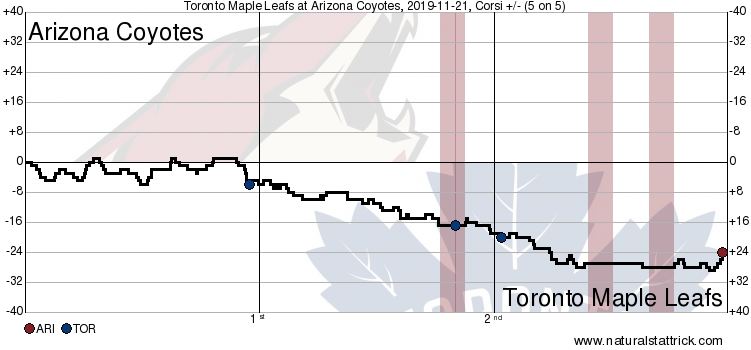As coaching debuts go, this one couldn’t have gone much better for Sheldon Keefe.
Tavares collects the puck for Keefe's first career win. #LeafsForever pic.twitter.com/mSARHpCbNJ
— Maple Leafs Hotstove (@LeafsNews) November 22, 2019
Your game ten:
1. A 3-1 win in which the team scored first through Tyson Barrie’s first of the season and got the game-winner from recent Marlies grad Pierre Engvall shorthanded (after a good play at the defensive blue line by Justin Holl) is about as perfect as you could’ve scripted game one of the Sheldon Keefe era. Now add in that the team dominated not just the shot attempts (60%) but the high-danger scoring chances (70%) and expected goals (57%) at 5v5 throughout the 60 minutes, and that their 70 total shot attempts at 5v5 were more than any of their previous 23 games this season. Line by line, this was just what the doctor ordered for the Leafs.
2. The theme of the night is going to be the new vision and changes undertaken by Sheldon Keefe — and going forward, where he takes the systems and style of play now that he’s dictating the organizational program, not Babcock — but I am going to start off with what may sound like (but isn’t intended to be) a bit of an incendiary statement: That looked like the Leafs at their best between 2016-2018 under Babcock. Active D, lots of movement sowing chaos in the o-zone, the low-swinging option through the middle on the breakout with wingers releasing the zone to stretch the ice for the long bomb — the Leafs looked like they snapped back into the Leafs of old at times. More roaming offensively, a more active defense, still prone to their fair share of breakdowns defensively, and liable to ice the puck more than the average team (including several icings in a row at one point).
Is this the biggest gap between a defenseman and forward at 5v5 this season by the Leafs?
Get ready for some stretch plays. pic.twitter.com/8Ek6OS1YdZ
— Gus Katsaros🏒 (@KatsHockey) November 22, 2019
Once again, fwds are heading north on the regroup, no longer swinging back to head up as a unit.
This is good. It's also perilous, but I like the potential of good. pic.twitter.com/xQfF8cJ1YJ— Gus Katsaros🏒 (@KatsHockey) November 22, 2019
3. My account of it is that the biggest philosophical difference between Babcock and Dubas came down to Babcock wanting to push the team forward into what he felt was winning Springtime hockey— to evolve into a more polished defensive team that could win “boring” if it needed to — while Dubas wants to double down on the team’s clear strengths and try to win a championship his way.
The postmortem on the Babcock era is likely to be distorted by many. It’s not that Babcock disliked all the skill and speed on the roster — you can’t look at the types of lineups he’s iced over the years and think he doesn’t highly value skill, speed, and mobile puck-moving defensemen — it’s that he felt the next step in the evolution of this team was to teach all of that skill and speed to check, and he was willing to forgo some offense early in the regular season to do it. It has been interesting to hear people cite “active D” and “attacking in waves” like that isn’t the exact hockey Babcock preached ad nauseam with his Detroit teams, his past Leafs teams, and his Team Canada teams.
It’s going to be compelling for people to push the narrative Babcock was the dinosaur who valued grit over the offensive skill and finesse championed by Dubas, but that’s an oversimplification (and I’d argue Dubas and Shanahan never would have thought they might be able to make this marriage work if it were the case). Dating back to his Detroit days, he was ahead of his time in his views on where the game was headed (certainly in regards to the diminishing value of traditional toughness and fighting). He wants his team to play fast, skilled, heavy, and responsible over four lines — and he looked like he was relentlessly committed to forcing this team to evolve to play the way he believes championships are won (as is his prerogative as head coach of the team).
Based on how the team was loving life on the bench, whooping it up in the room after, and celebrating their newfound freedom in quotes to the media, Babcock wasn’t budging on certain demands one iota and many of the players were totally done with his voice and message.
Tyson Barrie: "That style that we played tonight, you'll see a lot more of it. Sure, we'll make mistakes & look silly sometimes, but we'll be rewarded for it a lot more than we won't be. That was a lot of fun out there tonight."
— Mark Masters (@markhmasters) November 22, 2019
Assuming the Leafs can get this turned around in time to be a playoff team, the biggest test of all of this is obviously going to come down the stretch and into the postseason. Keefe has won it all in the AHL, but he had a different personnel group that you could argue was more diverse in its ability to check and win different styles of games in the playoffs (there is always the caveat that there were some advantages over the field with the depth of talent and resources as well). Before a team can prove if it can or cannot win in the playoffs, though, you do have to make the playoffs first, and Babcock’s team was in serious risk of not even achieving that.
4. This is also why Babcock loved the comments from Alex Ovechkin earlier this month. He feels like that Capitals team went through a slow collective epiphany and committed to playing the right way before they finally won, and he didn’t want his young core to have to wait as long — and lose out of the playoffs as often — as Ovechkin did to really commit to the transformation. He may have been too rigid and pushed too hard for some of the players’ liking, and in the process, he lost a good number of the players’ belief and attention. Babcock would almost certainly argue the player group hadn’t learned/committed yet to playing right, and the players group may feel they tried it his way and it only made the game less fun, less offensive, and they still got scored on too much.
The proof will be in the pudding in time. It’s been done both ways; the Penguins won by being high-octane offensively with great goaltending despite a blue line (and some forwards) that were dodgy in its own end, albeit it was with a forward group that could grind and whose matured superstars knew what it took over 200 feet to win in the playoffs. The Capitals and Blues won by playing in a mold much closer to Babcock’s vision.
Babcock might say if you commit to playing right defensively (never happened) and grinding to get the puck back (an area of weakness for many Leaf forwards), the offense will come to the fore and it’s the kind of hockey that will win in the Spring. Dubas would argue that with this roster, keeping the puck as much as possible plays to the team’s strengths and is its most effective form of defense. I think that’s a real distinction between the two.
Either could win in the right circumstances, but the roster Dubas is building is unquestionably a team better suited to embrace the latter identity, for better or worse.
5. Where Babcock could be especially frustrating was in his rigidity about his line composition and refusal to adjust/experiment there. We’ve been accused of pumping the breaks some of the (outlandish) Babcock criticism around here (and stand by that), but this is the thing we have consistently spoken out against in the notebooks and game reviews on the site — he did not experiment enough for a coach with a skilled roster full of interesting possibilities. Deploying Hyman more on his strong side is a point we’ve been making around here since 2016. As Anthony Petrielli pointed out recently, while Tyson Barrie’s struggles early this season go beyond the coaching, Rielly and Barrie should at least be experimented with, and it was great to see Keefe go to it as a “let’s hit the reset button”-kind of move, albeit it was just to open the game before Barrie reunited with Travis Dermott.
With Babcock’s strict ideas around pairing and line combos, sometimes it felt like it was a case of if he wouldn’t trust it to protect a lead in the third period, why do it at all? But not developing a true understanding of the possibilities within the roster throughout the year can end up hurting you when push comes to shove — see the Game 7s in Boston where the Leafs were trailing, weren’t firing on all cylinders offensively, needed a spark, and seemed totally out of ideas.
Keefe’s adaptability is going to be the most interesting contrast to follow, not just in line combos and player deployment, but also in systems adaptations. In listening to most of his publicly available interviews over the years, I do believe Keefe thinks provided you can communicate something clearly to the players, even fairly dramatic system changes can be undertaken quickly and effectively, be it midseason or within the duration of a playoff series. That ability to communicate the how and why and achieve buy-in quickly — now at the highest level of the game — is going to be tested here by virtue of the timing of this move.
6. Worth noting: Babcock has said at coaching symposiums in the past that a coach has to go straight to his best players and be unafraid to challenge them to become the team leaders in how they commit to “doing it right” over 200 feet of the ice — “when the stars do it, the rest of the team has nowhere to hide.” It does feel like he never really connected all that well with the Matthews and Nylanders with his tone/message and approach, while it did seem to work well on others such as the departed Nazem Kadri. Matthews was fired up on the bench like we haven’t seen in some time after the Barrie goal and was beaming after the game. Not hard to read between the lines here.
7. The newfangled Mikheyev – Tavares – Hyman line out-attempted the opposition 24-8 and outshot them 12-5 at 5v5 tonight. It’s an ostensibly less “offensive” line than with Kapanen on the right, although not really. It’s three players who can check and they should spend lots of time in the offensive zone, where all three players on the line will attack the net — a big point of emphasis for Sheldon Keefe in turning their lagging 5v5 offensive numbers around.
After a bit of a sag in the first few weeks of November, Mikheyev has really come on strong again in the past two games of this road trip. He picked up an assist on the Matthews and Barrie goals tonight after generating a bunch of chances (and ringing the crossbar) vs. Vegas, and he has been his disruptive, all-around-the-puck self.
8. The heat map below shows a clear picture of how much better the Leafs looked offensively in the critical areas of the ice in this game. It’s true they were more active as five-man units in the o-zone, but they were also just way hungrier around the net and on the forecheck tonight. The systems and tactics will get a lot of play in the post-game chatter, but everything is set up by the work ethic and the commitment to winning the lion’s share of the puck races and battles. It looked like the “dead-cat bounce” was in full effect in this regard.

9. Among the other combinations, it was clear to see that Keefe set out to breathe more confidence into two Dubas adds who were off to slower, or at least mixed, starts in Tyson Barrie and Jason Spezza — even with Kerfoot back, Spezza stayed in the middle next to two good linemates in Kerfoot and Kapanen. I’m not at all sold on Spezza as a better full-time center option over Kerfoot with his pace and defensive limitations, but he was involved offensively with lots of touches playing the middle and tracked back well a few times. Kerfoot isn’t 100% right now anyway, so we’ll have to see if this sticks over time.
The biggest standout among the time-on-ice figures: Travis Dermott‘s season-high 17:18. Really good odds he’s got a bigger fan in Keefe than he did in Babcock.
And there it is, Tyson Barrie finally has his first of the year. 1-0 Leafs. #LeafsForever pic.twitter.com/frRmNVPPrC
— Maple Leafs Hotstove (@LeafsNews) November 22, 2019
10. The other way they looked like the Leafs of old: Frederik Andersen making consistently timely saves. Again the team had a let-off after a goal was scored — it’s a bad tendency in their game this season — and he made a huge save in tight to keep it at 1-0. Just before their 1-0 goal, the team nearly fell behind first yet again as well if not for a massive glove save on a point-blank scoring opportunity for Carl Soderberg in the slot. With how mentally fragile the team has been of late, we may well have been singing a much different tune right now if he didn’t come up with big saves there.
Hockey commentary is full of overused, lazy cliches, but I’m not sure there is one closer to the truth than, “Show me a good coach and I’ll show you a good goalie.”
Game Flow: 5v5 Shot Attempts





































